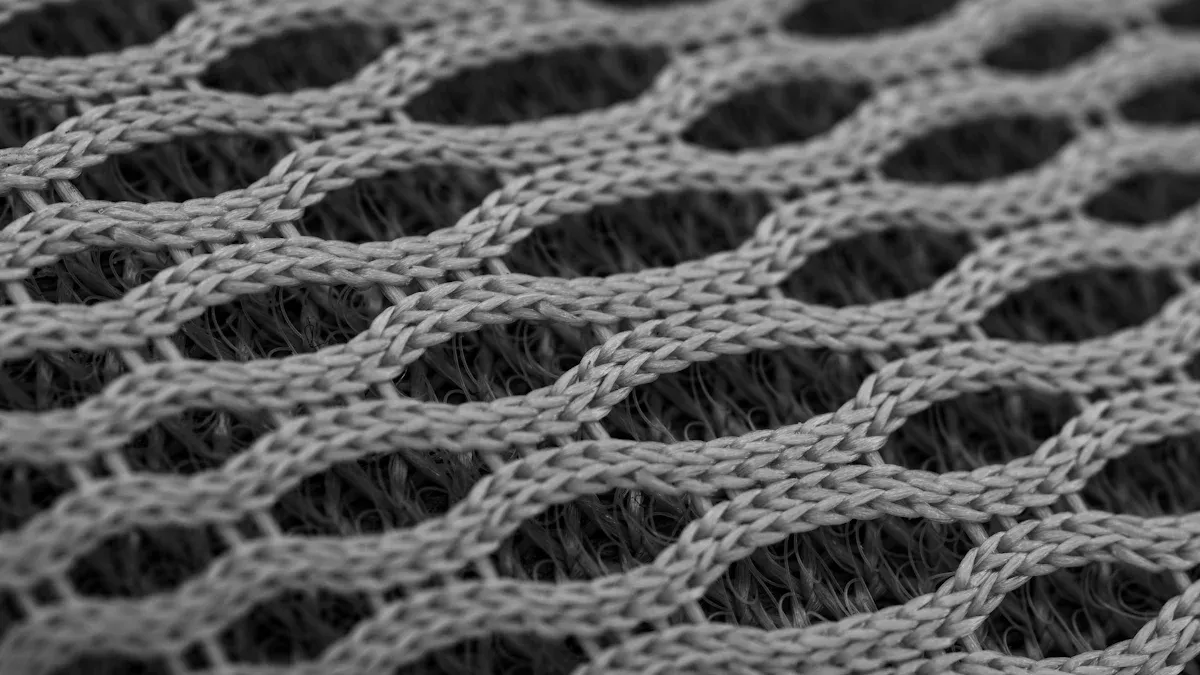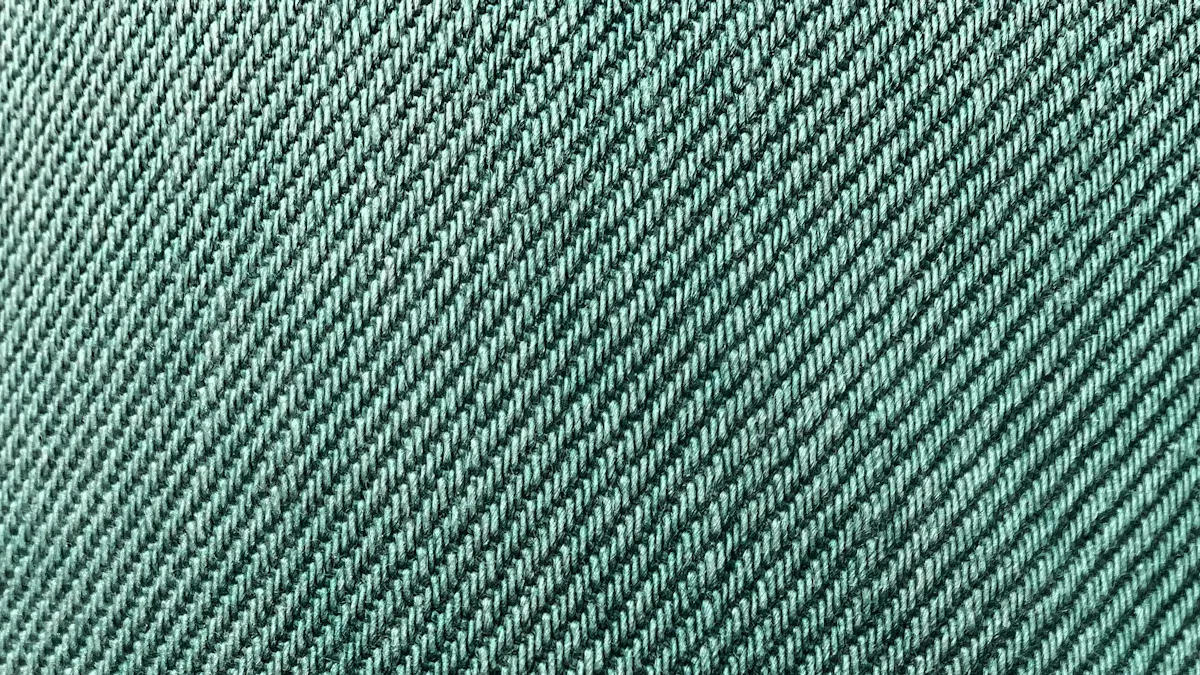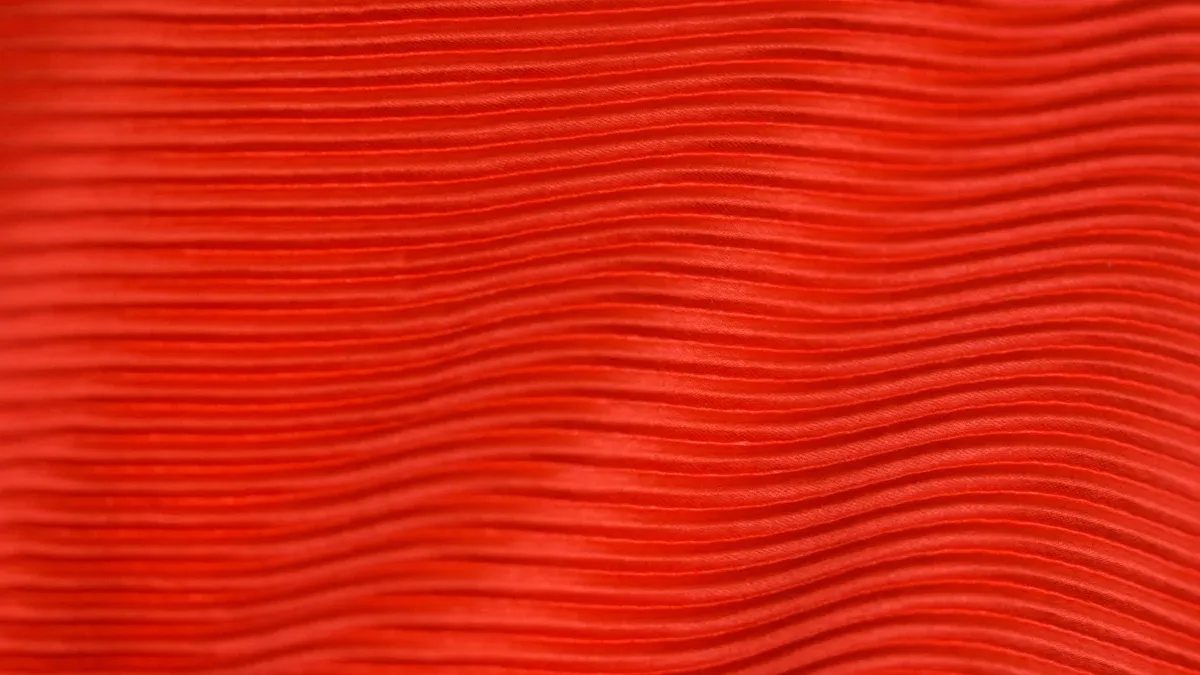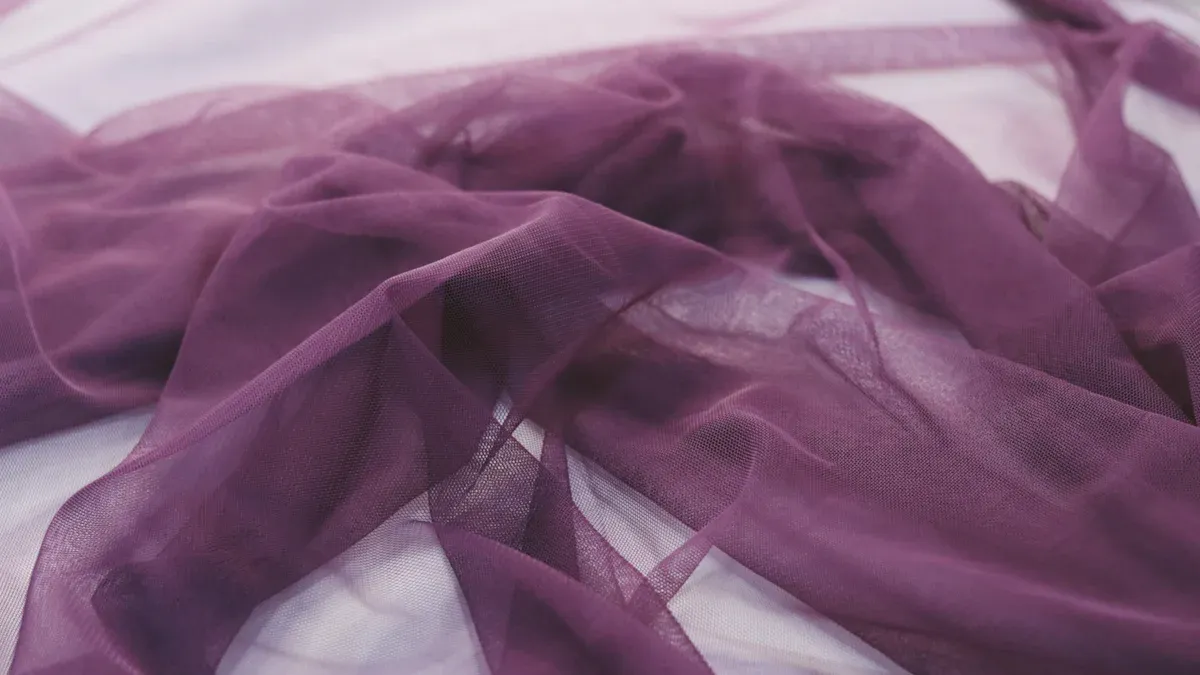
You often see mesh fabrics in many products, but cotton mesh fabric stands out for its unique feel and natural comfort. Cotton mesh fabric uses a soft, open structure that allows air to flow, making it ideal for both fashion and practical uses. You may notice that mesh fabric made from cotton is chosen when comfort and hypoallergenic qualities matter most, especially in clothing and medical textiles. While synthetic mesh fabrics like polyester and nylon dominate the market because of their durability and cost, cotton mesh remains a top pick for people who value breathability and natural materials. Mesh fabric offers versatility, and cotton mesh provides a gentle touch that suits various uses in fashion and beyond. Mesh has become a staple in everyday life, with mesh fabrics appearing in everything from sportswear to accessories. Cotton mesh fabric gives you a balance of comfort and style, making it a preferred option where softness and function meet.
Key Takeaways
- Cotton mesh fabric offers excellent breathability and comfort due to its open weave and natural fibers, making it ideal for warm weather and sensitive skin.
- This fabric is lightweight, soft, and versatile, suitable for fashion, activewear, accessories, household items, and industrial uses.
- Cotton mesh requires gentle care to prevent shrinkage and creasing; washing in cold water and air drying helps maintain its quality.
- Choosing cotton mesh supports sustainability because it is biodegradable, recyclable, and can come from organic cotton with eco-friendly certifications.
- While cotton mesh absorbs moisture well, it dries slower than synthetic meshes, so it suits everyday wear and light exercise better than high-intensity sports.
Cotton Mesh Fabric: Structure and Unique Properties

Open Weave and Composition
You can recognize mesh fabrics by their open, net-like structure. Cotton mesh fabric uses natural cotton fibers spun into yarns, which are then woven or knitted to create a pattern of small holes. This open weave lets air and light pass through, making the fabric lightweight and breathable. The grid-like pattern you see in mesh fabric is not just for looks. It plays a big role in how the fabric feels and works.
- Cotton mesh fabric uses longer natural fibers, which give it a soft and comfortable touch.
- Synthetic mesh fabrics, such as those made from polyester or nylon, use shorter fibers and focus on strength and durability.
- The weaving or knitting process creates a consistent pattern of holes, which helps with ventilation and airflow.
- Cotton mesh fabric stands out for its gentle feel, while synthetic mesh fabrics often offer more elasticity and color retention.
Note: The open weave of cotton mesh fabric increases air permeability. This means you get better breathability and ventilation, which is important for clothing and activewear. The structure also makes the fabric lightweight, so you feel less weighed down when you wear it.
Key Characteristics of Cotton Mesh
When you look at mesh fabrics, you notice several features that make them useful for many purposes. Cotton mesh fabric has some unique qualities because of its structure and fiber content.
- Breathability: The open weave allows air to move freely, keeping you cool and comfortable. This makes cotton mesh fabric a great choice for warm weather or active use.
- Lightweight: Cotton mesh fabric feels light on your skin. You can wear it for long periods without feeling heavy or restricted.
- Ventilation: The holes in the mesh fabric help with ventilation. This means sweat and heat can escape easily, which is helpful during exercise or in hot climates.
- Softness: Cotton fibers give the mesh fabric a soft, gentle feel. You can wear it directly against your skin without irritation.
- Flexibility: The open weave adds some stretch and movement, but the self-locking effect in certain weaves can make the fabric less flexible than plain woven mesh fabrics.
- Strength: The way the yarns twist and lock together in the weave gives the fabric mechanical strength. This helps the mesh fabric keep its shape and last longer.
- Versatility: You can use mesh fabrics in many ways, from clothing and accessories to household and industrial products.
Mesh fabrics, especially those made from cotton, balance comfort and function. The open weave structure gives you breathability, lightweight comfort, and ventilation, making cotton mesh fabric a popular choice for both fashion and practical uses.
Benefits and Drawbacks of Cotton Mesh Fabric
Breathability and Comfort
When you choose mesh fabrics for clothing, you often look for breathability and comfort. Cotton mesh fabric stands out as a breathable mesh fabric because of its open weave and natural cotton fibers. The structure lets air move freely, which helps keep your body cool and dry. You feel the difference when you wear mesh fabric in warm weather or during physical activity. The lightweight design means you do not feel weighed down, and the mesh allows sweat to evaporate quickly.
Scientific studies show that cotton mesh fabric absorbs moisture well and helps with ventilation. Laboratory tests reveal that cotton mesh has higher air permeability than regular cotton, with values ranging from 500 to 3000 L/m²/s. This means you get more airflow than with dense cotton fabrics. The natural hydrophilic fibers in cotton mesh absorb sweat, making it a comfortable choice for activewear and summer clothing. A 2022 review found that cotton mesh can improve thermal sensation and reduce sweat loss during exercise in heat. You may notice that mesh fabric for clothing made from cotton feels soft and gentle on your skin, which is important for sensitive skin or children’s wear.
However, when you compare cotton mesh to high-tech synthetic mesh fabrics, you see some differences. Synthetic mesh fabrics often have advanced moisture-wicking properties, which means they move sweat away from your skin and dry faster. Cotton mesh absorbs moisture well but does not wick it away as quickly as engineered synthetics. Still, the breathability and comfort of cotton mesh make it a popular choice for those who prefer natural fibers.
Tip: If you want a breathable mesh fabric that feels soft and natural, cotton mesh fabric is a great option for everyday wear and light exercise.
Durability and Versatility
You benefit from the durability and versatility of mesh fabrics when you use cotton mesh in your daily life. The durability of mesh fabric depends on the strength of the cotton fibers and the way the mesh is woven. Cotton mesh fabric holds up well to regular use, especially when you follow proper care instructions. The open weave gives the fabric flexibility, so you can use it in many different ways.
Here are some benefits of choosing mesh fabric for various applications:
- Cotton mesh fabric is lightweight, making it easy to wear and move in.
- The breathable mesh structure supports ventilation, which is ideal for sportswear, activewear, and summer clothing.
- Cotton mesh is hypoallergenic and soft, so it works well for sensitive skin and children’s clothing.
- You can dye and print cotton mesh in many colors and patterns, which adds style to fashion items.
- The fabric is eco-friendly and biodegradable, which supports sustainability trends.
- Mesh fabrics are used in packaging, agriculture, and even construction, showing their wide range of uses.
| Application Area | Benefits of Choosing Mesh Fabric |
|---|---|
| Fashion & Clothing | Lightweight, breathable, stylish |
| Sports & Activewear | Moisture-wicking, ventilation, comfort |
| Industrial Uses | Flexible, durable, eco-friendly |
| Household Items | Soft, hypoallergenic, easy to clean |
The versatility of cotton mesh fabric comes from its unique combination of comfort, breathability, and lightweight design. You can find mesh fabric for clothing, accessories, bags, and even industrial products. The durability and moisture-wicking properties of cotton mesh make it a reliable choice for many needs.
Potential Disadvantages
While cotton mesh fabric offers many benefits, you should also know about some potential drawbacks. Mesh fabrics made from cotton have a looser weave, which can affect their performance in certain situations. Scientific reviews point out that cotton mesh fabric tends to have poor elasticity and may crease easily. The molecular structure of cotton fibers, with both crystalline and amorphous regions, causes this tendency to wrinkle. You may notice that cotton mesh fabric needs more care to stay smooth and neat.
Shrinkage is another factor to consider. Cotton mesh fabric, like other cotton textiles, can shrink after washing. The looser structure of mesh fabric allows for more dimensional change, so you might see shrinkage rates between 4% and 10%. This is similar to other non-pre-shrunk cotton fabrics but can be higher than denser cotton textiles. Washing temperature and mechanical action also play a role in how much the fabric shrinks.
| Fabric Type | Shrinkage Range (%) | Notes on Structure and Shrinkage Behavior |
|---|---|---|
| Cotton (non-pre-shrunk) | 4–10 | Typical shrinkage range for untreated cotton fabrics |
| Cotton Mesh Fabric | ~4–10 | Looser weave may cause shrinkage at upper end of the range |
| Cotton-Polyester Blend | 1–3 | Lower shrinkage due to synthetic fiber content |
You may also find that cotton mesh fabric does not match the advanced moisture-wicking properties of some synthetic mesh fabrics. While cotton mesh absorbs moisture well, it does not transfer sweat away from your skin as quickly as engineered synthetics. This means that for high-intensity sports or very humid conditions, you might prefer a synthetic breathable mesh.
Note: If you want to reduce shrinkage and creasing, look for pre-shrunk cotton mesh fabric or blends with synthetic fibers.
Overall, the benefits of choosing mesh fabric like cotton mesh include breathability, comfort, lightweight feel, and versatility. You get a natural, eco-friendly option that works well for many uses, but you should be aware of its care needs and performance limits in certain situations.
Fashion Applications of Cotton Mesh Fabric

Clothing and Activewear
You see mesh fabric for clothing in many styles today. Designers use mesh in tops, tank tops, shorts, leggings, and jackets. Most activewear brands choose synthetic mesh for its strength and quick-drying features. You find these materials in sportswear from brands like Nike and Adidas. Cotton mesh fabric, however, appears more in luxury and designer clothing. High-end designers use cotton mesh in wedding gowns, lace dresses, and special occasion outfits. The soft touch and breathability of cotton mesh make it a favorite for summer clothing and fashion pieces that need comfort and style. You may notice that mesh fabric for clothing made from cotton is less common in mainstream activewear, but it stands out in designer collections. The trend toward sustainable materials is growing, so you might see more cotton mesh in future activewear and fashion.
Accessories and Linings
You can find mesh fabric in many accessories and linings. Designers use cotton mesh in scarves, tote bags, and pouches. The lightweight and open weave add style without extra weight. Cotton mesh linings in jackets and bags help air flow and keep you cool. You feel more comfortable because the mesh lets heat escape. Some backpacks and travel organizers use cotton mesh for breathability and visibility. The soft texture of cotton mesh makes it a good choice for items that touch your skin. You also see mesh fabric in linings for leather jackets, where it helps prevent overheating. Mesh adds both function and fashion to accessories.
- Cotton mesh is breathable and eco-friendly.
- Mesh linings improve airflow and comfort.
- Mesh fabric adds texture and style to accessories.
Notable Products Featuring Suerte
You can explore many mesh fabric options from Suerte Textile. Suerte offers cotton mesh fabric for clothing, accessories, and linings. The company uses advanced machinery to create high-quality mesh fabric. You get a wide range of choices, from soft cotton mesh for fashion to durable mesh for practical uses. Suerte supports custom designs, so you can match your style or project needs. The team helps you select the right mesh fabric for clothing, bags, or even special linings. Suerte’s quick response and design support make it easy for you to bring your fashion ideas to life. You benefit from their one-stop service, which covers everything from pattern design to production.
Functional Applications of Mesh Fabrics
Household and Everyday Uses
You encounter mesh fabrics in many household products. Mesh fabric uses include laundry bags, reusable produce bags, and lightweight curtains. These items benefit from the breathability and moisture-wicking properties of cotton mesh. You can wash and reuse these products easily, which makes them practical for daily life. Mesh fabrics also appear in storage organizers and shoe bags. The open structure allows air to flow, keeping your items fresh. You find mesh in bath sponges and cleaning cloths because it dries quickly and resists odors. Mesh fabric comes in many colors and patterns, so you can match your home style. The durability of mesh means these products last longer than some alternatives.
- Laundry bags
- Produce bags
- Curtains
- Storage organizers
- Bath sponges
Tip: Choose mesh fabric for items that need to stay dry and clean. The breathable mesh fabric helps prevent mold and mildew.
Industrial and Medical Applications
You see mesh fabrics in many industrial and medical settings. Mesh fabric uses in industry include safety vests, tarps, cargo nets, and seat supports. These products rely on the strength and durability of mesh. In medical environments, mesh fabrics appear in curtains, IV bag supports, and orthopedic braces. The mesh must meet strict safety and hygiene standards. You benefit from mesh that is non-toxic, non-allergenic, and antimicrobial.
| Application Sector | Uses of Mesh Fabrics | Performance Standards Met |
|---|---|---|
| Industrial | Safety vests, tarps, cargo nets, seat supports | ANSI, ASTM, AATCC |
| Medical | Curtains, IV bag supports, braces, slings | Biocompatible, antimicrobial, non-toxic |
Mesh fabrics in these areas must be strong and reliable. The moisture-wicking ability of mesh helps keep workers and patients comfortable. Mesh fabric uses in healthcare also include bandages and dressings, where breathability and softness matter.
Sports and Outdoor Gear
You find mesh fabrics everywhere in sports and outdoor gear. Mesh fabric uses include sports jerseys, backpacks, hats, and shoes. The open weave keeps you cool during activity. Mesh fabrics offer moisture-wicking, so sweat moves away from your skin. This helps you stay dry and comfortable. Mesh also appears in camping chairs, tents, and fishing vests. The durability of mesh means your gear can handle tough conditions. Mesh fabric uses in sports include lining for helmets and pads, where breathability and comfort are important. You rely on mesh for lightweight, strong, and practical equipment.
Note: Mesh fabrics make outdoor adventures more enjoyable by providing comfort, moisture-wicking, and durability.
Mesh fabrics play a key role in many parts of your life. The applications of mesh fabrics range from home products to industrial safety and sports gear. You benefit from the breathability, moisture-wicking, and durability that mesh fabric provides.
Care and Maintenance for Cotton Mesh
Washing and Drying Guidelines
You want your cotton mesh fabric to last and look good. Follow these steps to keep it in top shape:
- Wash cotton mesh in cold or warm water on a gentle cycle. This helps prevent shrinkage and protects the open weave.
- Turn garments inside out before washing. This reduces friction and keeps the mesh surface smooth.
- Use a mild, residue-free detergent like Sport-Wash or Sensi-Clean. These detergents help maintain the fabric’s breathability and softness.
- Avoid fabric softeners. They can clog the mesh and reduce airflow.
- Separate colors and pretreat stains before washing.
- For drying, air dry your cotton mesh by laying it flat or hanging it up. If you use a dryer, choose low or medium heat to avoid shrinking or damaging the fibers.
Tip: High-efficiency washing machines with gentle cycles help reduce wear and extend the life of your cotton mesh items.
Stain Removal Tips
Stains can happen, but you can handle them with care. Act quickly for the best results:
- Blot stains gently with a clean cloth. Do not rub, as this can push the stain deeper into the mesh.
- Use a mild stain remover or a mixture of water and gentle detergent. Test on a small area first.
- For tough stains, soak the cotton mesh in cold water with a bit of detergent before washing.
- Avoid bleach or harsh chemicals. These can weaken the cotton fibers and damage the mesh structure.
Note: Always check the care label for special instructions before treating stains.
Storage Recommendations
Proper storage keeps your cotton mesh fabric fresh and ready to use. Here are some best practices:
| Aspect | Recommendation |
|---|---|
| Storage Environment | Store in a cool, dry place. Avoid basements or attics where moisture can build up. |
| Pest Protection | Keep storage areas clean. Use cedar blocks or lavender sachets to deter pests naturally. |
| Avoid Overcrowding | Do not pack items too tightly. This prevents creasing and helps air circulate. |
| Folding vs Hanging | Fold cotton mesh items to prevent stretching. If you hang them, use wide padded hangers. |
- Always dry cotton mesh completely before storing to prevent mold and mildew.
- Use moisture-absorbing packets during wet seasons or for long-term storage.
- Avoid airtight containers. Good airflow helps keep the fabric fresh.
Tip: Store your cotton mesh in a well-ventilated area to maintain its shape and quality.
Environmental Impact and Sustainability of Cotton Mesh Fabric
Cotton Sourcing and Production
When you choose mesh fabrics made from cotton, you support a natural fiber with both benefits and challenges. Cotton farming uses a lot of water and often relies on pesticides. This can lead to soil problems and water pollution. Some regions also face labor issues, including forced and child labor. You may see these problems in places like Uzbekistan and parts of China. The supply chain for cotton mesh is complex, making it hard to track every step.
| Aspect | Impact/Issue | Explanation |
|---|---|---|
| Environmental Resource Use | High water and pesticide use | Cotton farming can cause water stress and soil contamination. |
| Labor Issues | Forced and child labor | Some regions report unfair labor practices in cotton production. |
| Supply Chain Complexity | Lack of transparency | Tracking cotton from farm to fabric is difficult. |
| Sustainable Practices | Organic and fair-trade cotton, certifications | These options reduce chemicals and support fair labor. |
| Economic and Social Equity | Farmer vulnerability | Small farmers face price changes and income risks. |
| Climate Change Impacts | Extreme weather | Climate change makes cotton farming less predictable. |
You can look for mesh fabrics with certifications like GOTS or OEKO-TEX. These labels show that the cotton was grown and processed with care for people and the planet. Organic cotton uses less water and fewer chemicals, making it a better choice for sustainable fashion.
Eco-Friendly Practices and Longevity
You help the environment when you pick mesh fabrics made from organic cotton. Organic cotton uses up to 91% less water and 62% less energy than regular cotton. It also produces fewer emissions and less soil erosion. When you buy mesh fabrics with eco-friendly certifications, you support better farming and safer working conditions. Mesh fabrics made from natural fibers last a long time if you care for them well. This means you can use your mesh items for many years, which reduces waste and supports sustainable fashion.
Tip: Choose mesh fabrics with eco-labels to make a positive impact on the environment and support ethical production.
Recyclability and Biodegradability
You can feel good about using cotton mesh fabrics because they are both recyclable and biodegradable. Cotton mesh breaks down naturally over time, so it does not add to landfill waste. You can recycle cotton mesh fabrics, especially if they are pure cotton. Most recycled cotton comes from factory scraps, but some programs collect used mesh fabrics for recycling. Synthetic mesh fabrics, like polyester or nylon, do not break down and can pollute the environment with microplastics. When you wash synthetic mesh, tiny plastic fibers enter rivers and oceans. Cotton mesh fabrics avoid this problem, making them a better choice for sustainable fashion.
- Cotton mesh fabrics are made from renewable resources.
- You can compost old cotton mesh, turning it into soil.
- Synthetic mesh fabrics are harder to recycle and do not biodegrade.
- Choosing cotton mesh fabrics helps reduce microplastic pollution.
You support a cleaner planet when you select mesh fabrics made from cotton. These fabrics fit well with the goals of sustainable fashion and help you make responsible choices.
Cotton mesh fabric gives you many options for both fashion and practical uses. You benefit from its breathability, lightweight feel, and comfort.
- Mesh fabrics work well in sportswear, medical textiles, outdoor furniture, and everyday clothing.
- You find cotton mesh easy to care for and long-lasting.
| Application Area | Unique Benefits |
|---|---|
| Sportswear | Breathability, comfort |
| Outdoor Furniture | Airflow, quick drying |
| Medical Textiles | Moisture management |
| Fashion & Apparel | Lightness, customization |
Suerte’s cotton mesh fabrics meet high standards for quality and sustainability. You can trust their products for reliable performance and ethical sourcing. Explore cotton mesh fabric for your next project or wardrobe update.
FAQ
What makes cotton mesh fabric different from synthetic mesh?
You get a softer, more breathable fabric with cotton mesh. Synthetic mesh, like polyester, offers more stretch and dries faster. Cotton mesh feels gentle on your skin and works well for sensitive users.
Can you dye or print on cotton mesh fabric?
Yes, you can dye or print on cotton mesh. The natural fibers absorb color well. You see vibrant results, especially with professional dyeing or printing methods.
How do you prevent cotton mesh fabric from shrinking?
Wash your cotton mesh in cold water and use a gentle cycle. Air dry or use low heat. These steps help you keep the fabric’s shape and size.
Is cotton mesh fabric suitable for people with allergies?
Cotton mesh fabric works well for people with sensitive skin or allergies. The natural fibers reduce irritation. You avoid many chemicals found in synthetic fabrics.



